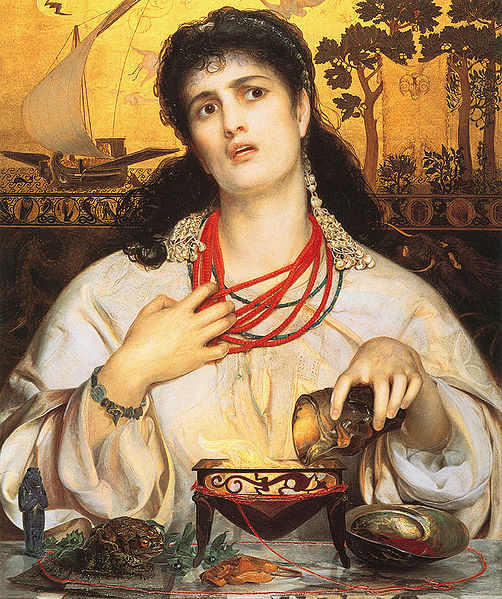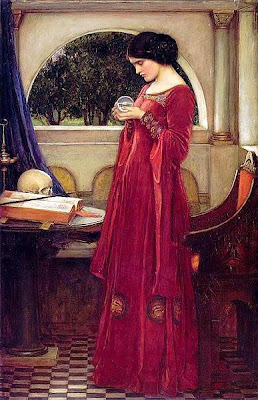John William Waterhouse: Jason and Medea (1907)
So here we are for a second week with Victorian and Edwardian witch paintings.
Having paid our respects to
Circe, we're still with Greek mythology for the moment, but looking at an even scarier witch.
Medea was actually Circe's niece, a priestess of the underworld/witchcraft goddess Hecate, and daughter of the king of Colchis (now Georgia). When Jason and the Argonauts arrived at her father's palace in search of the Golden Fleece, Medea fell in love and agreed to help him.
Anthony Frederick Sandys: Medea (1868)
She brewed up a sleeping potion to defeat the dragon that guarded the Fleece. What I like about this particular picture (which has some great magical detail, like the toad with the stone in its forehead, and the circle of red thread) is the sense of premonition - the look on Medea's face suggesting she sees the dark events ahead. The bright necklace suggesting blood.
Herbert Draper: The Golden Fleece (1904)
Fleeing with the stolen Fleece, the Argonauts are pursued by Medea's father. To slow him down, she
kills her younger brother - in some versions she hacks him to pieces as they will take longer to retrieve - and dumps the body overboard, knowing that the king will have to stop and give the corpse a proper funeral.
Medea is brick-hard. To the Victorian artist she epitomises woman as terrifying, psychotic and ruthlessly possessive,
Alphonse Mucha: Medee (1898)
This is an episode from nearer the end of Medea's story, as depicted on a theatrical poster. It's Art Nouveau style rather than Pre-Raphaelite. Medea finds that Jason has deserted her for an advantageous marriage to a princess. So she kills both their children as an act of revenge, and flies off in a chariot drawn by dragons. I've got a full-sized repro of this poster on my stairs at home!
Sir Edward Burne-Jones (1833-1898): The Beguiling of Merlin
Moving on from Greek myth to Arthurian legend, the witch
Nimue comes a bit of light relief, relatively speaking. She seduces the wizard Merlin, learns his magic, and uses his own spells to bind him forever into a tree. I used to love this picture (I think Merlin looks hot!) until I realised how distorted are the proportions of Nimue's body. Sadly, I can't
stop noticing that now and I find it just too irritating to look at :-(
I used this legend as a central plot device in my novel
Wildwood.
Anthony Frederick Sandys: Morgan le Fay (1864)
This is
Morgan le Fay, another Arthurian witch: Arthur's antagonistic half-sister and the mother of Mordred, who kills him. Blimey, standards of behaviour in the Good Old Days...
Take a look at the embroidery on her overdress. Those are genuine
Pictish symbols copied from standing stones in Scotland. I presume the artist used antiquarian travel-books as his source, but it's still a splendid piece of research.
John Collier: The Oracle or The Priestess of Delphi (1891)
The
Pythia - the priestess of Delphi - wasn't really a witch, more a shaman-type. She would sit on the tripod chair as depicted, breathing in the poisonous fumes from a fissure in the earth (supplemented by the burning of laurel leaves sacred to Apollo, also poisonous) and - completely stoned - she would prophesy in ecstatic gibberish which was interpreted by priests, to enquirers, in exchange for cash.
John William Godward: The Delphic Oracle (1899)
I think Godward has pretty much abandoned all pretence that the interest in these depictions lies in mysticism and ancient history.
George Wilson: The Spring Witch (1880)
Ditto Wilson. Interesting that the background is almost medieval in style - reminiscent of
Bruegel.The witch is depicted as a semi-divine figure bringing Spring to a wintery world.
Arthur Wardle: The Enchantress (1901)
Whereas
this is most reminiscent of a Sunlight Soap advert. I think her flushed face would probably have been considered rosy and attractive at the time.
John William Waterhouse: The Crystal Ball (1902)
Of course Waterhouse would have to make an appearance in this post somewhere! In fact, twice. The subject of the painting above is definitely a witch and, judging by her accoutrements, not necessarily a very nice one either ... just the way Waterhouse likes them. Actually, it may have been a a bit too menacing for some tastes - in the 1950s a purchaser of this picture had the skull painted out! This was discovered by use of X-ray in 1994 and it's been restored since.
John William Waterhouse: The Magic Circle (1886)
But oh, this is my favourite witch painting. The realism, the detail - note the ancient Greek style figures embroidered on her robe, and the wild herbs she's gathered - the grim Mediterranean setting among the tombs and discarded bones, the sense that she
really means what she's doing. See how the magic circle
burns as she inscribes it! Just a brilliant picture. And she doesn't even have the usual Waterhouse Face.



























































